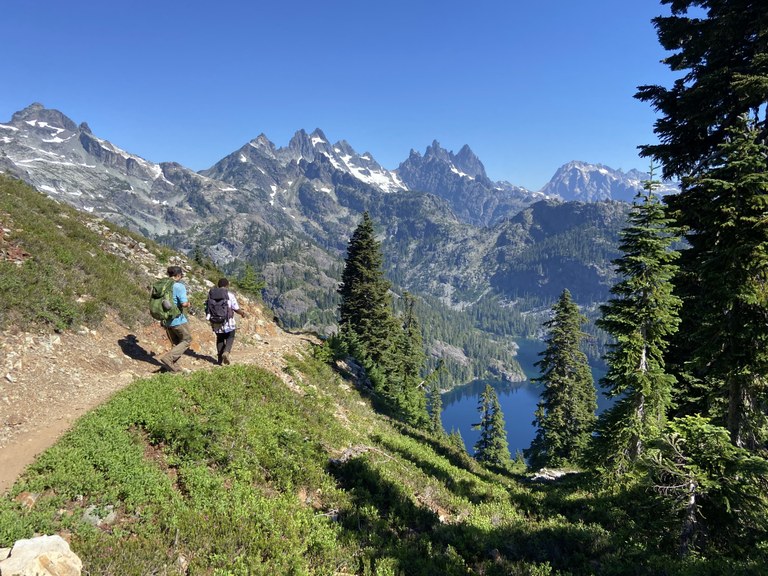 Washington Trails
Association
Washington Trails
Association
Trails for everyone, forever
WTA tackles tough projects in the backcountry with the help of both volunteers and paid trail crews. Both are powerful, and their respective skill sets help us coordinate projects statewide. By Joseph Gonzalez
Washington Trails Association began in 1966 as Signpost, a grassroots magazine for trail users in the Northwest to share beta on trail conditions and rehash their outdoor experiences. WTA’s efforts to preserve trails and bolster the outdoor community have taken many forms since then, but the foundation has always been the same: WTA is a culture built on volunteerism and a deep love for trails.
This passion is why Greg Ball created our trail maintenance program 30 years ago. Since then, our program has continued to adapt to meet the needs of Washington hikers. One big adaptation was in 2017, when we started our Lost Trails Found campaign, a concentrated effort to keep backcountry trails on the map. Since then, Lost Trails Found has focused our efforts in specific regions and strengthened community partnerships to protect backcountry trails. We were already working in the backcountry, but through Lost Trails Found we’ve offered focused volunteer opportunities to preserve trails through backcountry response teams, volunteer vacations and day work parties.

The combined efforts and experience of crew leaders, assistant crew leaders and crewmembers, both paid and volunteer, fuel our work statewide. Photo by Joseph Gonzalez
Our volunteer crews do an unbelievable amount of work, and do so with expertise and seemingly endless dedication. But to help add even more capacity to our trail maintenance program, we started exploring how paid crews could fit into the picture. We piloted a partnership with Northwest Youth Corps in 2018 and 2019, those paid crews helped get to more areas in need of work in the backcountry. Then in 2021, WTA started our own professional crew. This crew was structured to address backcountry trail maintenance needs that were challenging with our standard volunteer model.
Our Lost Trails Found crews are built on the amazing system we already have with our volunteers. Both our paid and volunteer crews are made up of experienced, skilled team members who work in remote sections of wilderness. Our volunteers bring their skills and the power of numbers — together they donate thousands of hours to Lost Trails Found projects every year. Our Lost Trails Found crews are smaller in number, but because this is their full-time job for the summer, they’re able to tackle some tasks that wouldn’t be possible with volunteer crews due to hitch length (number of days scheduled to work), project location and other factors.

Many volunteers have years of trail experience on all sorts of projects — from the smallest retaining wall, to the largest crosscut. Photo by Patrick Sullivan
We appreciate that our volunteers only have so much time to dedicate to trails, so we try to create experiences for them that will be both memorable and enjoyable. We try then, for instance, not to ask a volunteer crew to cut back brush for 8 days straight. Or ask them to move camp every single day for an entire week. Sometimes, though, we do need our paid crews to do that sort of work. And sometimes we need them to get deeper into the backcountry than we have time for on a volunteer crew. For some potentially hazardous projects (like rockslides or burn areas) the work has to be done by paid crews, due to our agreements with land managers. Because the Lost Trails Found paid crews are consistent, we can also more easily estimate how much they can get done in a set period of time. That helps us maximize what we can do over a season.
In some cases, volunteers and paid crews work on the same area to get more done. For instance, the Entiat is a special place for WTA. Volunteer crews have been working there since 2017, and it hosted the first Lost Trails Found hitch in 2021. This year we built on that legacy. Two volunteer backcountry response teams and two Lost Trails paid crews took turns working on the same trails, building momentum and investing nearly 2,000 hours of trail maintenance.

We're proud our backcountry work makes beautiful trails, like those in Alpine Lakes Wilderness, remain accessible. Photo by Kyvan Elep
As our Lost Trails Found season starts to come to a close, we want to thank all of the volunteers — all 3,200 of you — who came out and helped us keep trails on the map. And we also want to thank our Lost Trails Found staff. Without all of you, we would not be able to accomplish our goals. Your skills and dedication are helping hikers enjoy the powerful experience of exploring deep into the backcountry. Thank you!